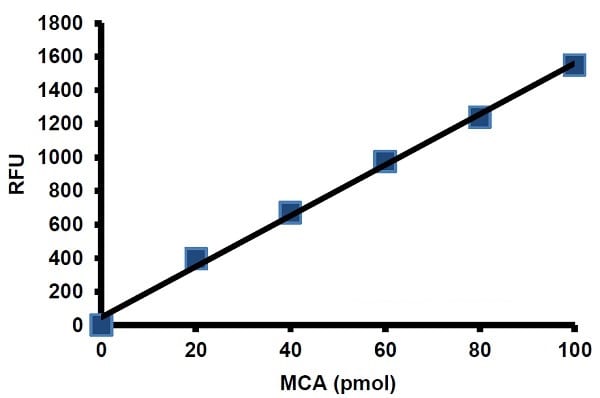Cathepsin E Activity Assay Kit (Fluorometric) (ab211081)
Key features and details
- Assay type: Enzyme activity (quantitative)
- Detection method: Fluorescent
- Platform: Microplate reader
- Sample type: Cell Lysate, Purified protein, Tissue Lysate
- Sensitivity: 1000 µU
Overview
-
Product name
Cathepsin E Activity Assay Kit (Fluorometric)
See all Cathepsin E kits -
Detection method
Fluorescent -
Sample type
Cell Lysate, Purified protein, Tissue Lysate -
Assay type
Enzyme activity (quantitative) -
Sensitivity
1000 µU -
Species reactivity
Reacts with: Mammals, Other species -
Product overview
Cathepsin E Activity Assay Kit (ab211081) provides a convenient method for detecting Cathepsin E activity in tissue and cell lysates. It is based on the ability of an active Cathepsin E to cleave a synthetic MCA-based peptide substrate to release free MCA, which can be easily quantified using a fluorimeter or fluorescence microplate reader at Ex/Em = 320/420 nm.
This assay kit is simple, rapid and can detect as low as 1 mU of Cathepsin E activity in biological samples.
-
Notes
Cathepsin E (CTSE, EC: 3.4.23.34) is a gastric aspartyl protease that functions as a disulfide-linked homodimer. This protease has a specificity similar to that of pepsin A and cathepsin D. It is an intracellular proteinase that is found in highest concentration on the surface of epithelial mucus-producing cells of the stomach. It is the first aspartic proteinase expressed in the fetal stomach and is found in more than half of gastric cancers.
-
Platform
Microplate reader
Properties
-
Storage instructions
Store at -20°C. Please refer to protocols. -
Components 100 tests CTSE Assay Buffer 1 x 25ml CTSE Lysis Buffer 1 x 25ml CTSE Substrate 1 x 200µl Human Cathepsin E (Positive Control) (50 µg) 1 vial MCA Standard (1 mM) 1 x 25µl -
Research areas
-
Function
May have a role in immune function. Probably involved in the processing of antigenic peptides during MHC class II-mediated antigen presentation. May play a role in activation-induced lymphocyte depletion in the thymus, and in neuronal degeneration and glial cell activation in the brain. -
Tissue specificity
Expressed abundantly in the stomach, the Clara cells of the lung and activated B-lymphocytes, and at lower levels in lymph nodes, skin and spleen. Not expressed in resting B-lymphocytes. -
Sequence similarities
Belongs to the peptidase A1 family. -
Post-translational
modificationsGlycosylated. The nature of the carbohydrate chain varies between cell types. In fibroblasts, the proenzyme contains a high mannose-type oligosaccharide, while the mature enzyme contains a complex-type oligosaccharide. In erythrocyte membranes, both the proenzyme and mature enzyme contain a complex-type oligosaccharide.
Two forms are produced by autocatalytic cleavage, form I begins at Ile-54, form II begins at Thr-57. -
Cellular localization
Endosome. The proenzyme is localized to the endoplasmic reticulum and Golgi apparatus, while the mature enzyme is localized to the endosome. - Information by UniProt
-
Alternative names
- CATE
- CATE_HUMAN
- Cathepsin E
see all
Images
-
Typical MCA standard calibration curve.
-
Cathepsin E activity in rat liver lysate (6 µg), rat kidney lysate (12 µg) and positive control (2 µL). Background control (blank standard); sample background (sample control without reaction mix).










